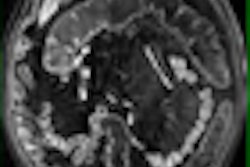For assessing the risk of coronary events, the absolute calcium score is a far better predictor of adverse coronary events than an adjusted score based on mean values of the patient's particular demographic group.
A study in the January 27 Journal of the American College of Cardiology used the hefty MESA (Multi-Ethnic Study of Atherosclerosis) database of 6,814 asymptomatic participants to tease out the different ages and races of patients who underwent a calcium scoring exam, following the patients for nearly four years on average (JACC, January 27, 2009, Vol. 53:4, pp. 345-352).
Recent results from other MESA database studies have shown that coronary artery calcium (CAC) scores improved event prediction after accounting for Framingham risk scores.
Organizations such as the National Cholesterol Education Program (NCEP) Adult Treatment Panel III, the American Heart Association (AHA), and the American College of Cardiology (ACC) have suggested that it might be reasonable to measure calcium scores in individuals of average risk.
But researchers have disagreed on the best way to measure and compare the results. With some data supporting the theory that having calcium above an age-specific level may carry additional risk, the authors decided to test the hypothesis that calcium mattered more if it exceeded certain levels compared to others in a demographic group, an analysis permitted by MESA's extensive demographic data.
"In this study we aim to establish whether absolute coronary artery calcium scores predict cardiovascular outcomes better than age-sex and/or race/ethnicity-specific CAC percentiles of the MESA cohort -- in other words, whether it is the actual amount of calcium present or the relative amount compared with others of the same age, sex, and race/ethnicity that is most strongly associated with risk," wrote Dr. Matthew Budoff from the Los Angeles Biomedical Research Institute at Harbor-UCLA Medical Center in Torrance, CA, in collaboration with other MESA researchers in the U.S.
The MESA study evaluated 6,814 asymptomatic participants between 2000 and 2002 for coronary heart disease (CHD) events after gated coronary artery calcium scoring was performed twice on each patient with either an MDCT scanner or electron-beam CT.
In the time since they were scanned, participants have been followed by telephone to log information about coronary events including myocardial infarction, angina, resuscitated cardiac arrest, or death from coronary heart disease. Medical records were also reviewed for evidence of coronary events. The time from scan to incident was modeled using Cox regression analysis, and models were further compared with percentiles based on age, sex, and/or race/ethnicity to categories commonly used (0, 1 to 100, 101 to 400, and > 400 Agatston units), according to the authors.
The researchers found 163 (2.4%) incident CHD events over a median follow-up period of 3.75 years. Expressing coronary artery calcium in terms of age- and sex-specific percentiles had significantly lower area under the receiver operator characteristics curve (AUC) compared to the use of absolute scores (women: AUC 0.73 versus 0.76, p = 0.044; men: AUC 0.73 versus 0.77, p < 0.001).
Comparing the incidence of CHD over time by CAC group, the absolute CAC categories "yielded curves with much better separation, indicating greater risk stratification ability," the authors wrote.
Both absolute and adjusted methods robustly predicted cardiac events (≥ 90th percentile associated with a hazard ratio [HR] of 16.4, 95% confidence interval [CI]: 9.30 to 28.9, and score ≥ 400 associated with HR of 20.6, 95% CI: 11.8 to 36.0).
Within groups based on age-, sex-, and race/ethnicity-specific percentiles, there remains a clear trend of increasing risk across levels of the absolute CAC groups, Budoff and colleagues added.
"In contrast, once absolute CAC category is fixed, there is no increasing trend across levels of age-, sex-, and race/ethnicity-specific categories," they wrote.
Thus, the data show that patients with low absolute scores are at low risk of cardiac events -- regardless of their age-sex-ethnicity percentile rank. Similarly, individuals with an absolute CAC score of 400 or higher are at high risk regardless of percentile rank in their group.
In addition, among individuals with CAC scores in the 75th percentile or higher for age-sex-race/ethnicity, compared with a reference group with CAC scores from 1 to 100, the hazard ratio for incident coronary heart disease after accounting for Framingham risk score was 2.50 (95% CI: 1.27 to 4.92) versus 5.58 (95% CI: 2.34 to 13.33), respectively.
In contrast, a higher adjusted percentile CAC in absolute CAC score categories was not associated with increased risk of incident coronary heart disease, the authors stated.
The results show no advantage and sometimes considerable disadvantage to expressing coronary calcium scores relative to age, sex, and/or ethnicity, Budoff and colleagues wrote. The overall calcium percentile is just as accurate as any other percentile ranking and far better than any age-adjusted ranking.
For example, a 50-year-old Hispanic woman with a coronary artery calcium score of 25 Agatston units would be at the 95th percentile relative to her age, sex, and ethnicity, with an annual risk of only 0.25% for CHD, the authors explained. On the other hand, a 72-year-old man with a score of 1,572 Agatston units would be only at the 72nd percentile for his age, sex, and ethnicity.
"However, the high absolute score drives the overall risk, and the annual risk is 2.8% (10-year estimated 28% risk)," the authors wrote. "So, the age-, sex-, and race/ethnicity-specific percentiles would say the Hispanic woman is at much higher risk. Clearly, the estimates from the age-, sex-, and race/ethnicity-specific percentile model do not reflect what we know about CHD risk. The overall percentiles provide a more realistic picture."
Rather than age-, sex-, and race-specific percentile models, the authors recommend using cut points for treatment based on the absolute CAC amount, noting that those cut points may still need to be adjusted for age and sex.
"If the goal is to identify and treat patients who have a particular level of risk, say at least 2% [per] year, then the CAC threshold for women will have to be higher than that for men, because women have lower baseline risk," Budoff and colleagues explained. "Using sex-based percentiles, however, actually does the opposite of this. By fixing the percentage of patients to target rather than the underlying risk, the threshold for women is lower than for men. Targeting the top 25% of each sex for instance, we would be treating women with much lower CAC scores and consequently at much lower risk than men."
Pending further study in a cohort with more adverse events to analyze, the common CAC cut points of 100 and 400 seemed to perform well, they concluded.
By Eric Barnes
AuntMinnie.com staff writer
January 23, 2009
Related Reading
Framingham risk doesn't predict plaque burden, January 5, 2009
Imaging studies seen as a better way to predict cardiac events, November 12, 2008
Echocardiography method predicts CAD, September 16, 2008
Multislice CT identifies coronary atherosclerosis in 'low-risk' patients, September 4, 2008
MRI evaluation of chest pain cuts acute coronary syndrome, August 15, 2008
Copyright © 2009 AuntMinnie.com




















